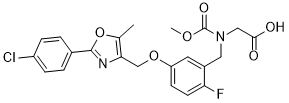|
BMS-711939, an analog of BMS-687453, is a novel potent and selective peroxisome proliferator activated receptor (PPAR) alpha agonist, with an EC50 and IC50 of 4 nM for human PPARα and >1000-fold selectivity vs human PPARγ (EC50 of 4.5 μM) and PPARδ (EC50 > 100 μM) in PPAR-GAL4 transactivation assays. BMS-711939 was chosen as a medication candidate for the treatment of dyslipidemia and atherosclerosis due to its strong pharmacological and safety profile in preclinical studies. Low-density lipoprotein-cholesterol (LDLc) and serum ApoA1 protein levels in mice are dose-dependently increased by BMS-711939 (10, 50, 100, p.o.).
|
Physicochemical Properties
| Molecular Formula |
C22H20CLFN2O6
|
| Molecular Weight |
462.86
|
| Exact Mass |
462.099
|
| Elemental Analysis |
C, 57.09; H, 4.36; Cl, 7.66; F, 4.10; N, 6.05; O, 20.74
|
| CAS # |
1000998-62-8
|
| Related CAS # |
|
| PubChem CID |
16727109
|
| Appearance |
Solid powder
|
| LogP |
4.674
|
| Hydrogen Bond Donor Count |
1
|
| Hydrogen Bond Acceptor Count |
8
|
| Rotatable Bond Count |
9
|
| Heavy Atom Count |
32
|
| Complexity |
636
|
| Defined Atom Stereocenter Count |
0
|
| SMILES |
ClC1C=CC(=CC=1)C1=NC(=C(C)O1)COC1=CC=C(C(=C1)CN(C(=O)OC)CC(=O)O)F
|
| InChi Key |
OPHWZEQODBXRCZ-UHFFFAOYSA-N
|
| InChi Code |
InChI=1S/C22H20ClFN2O6/c1-13-19(25-21(32-13)14-3-5-16(23)6-4-14)12-31-17-7-8-18(24)15(9-17)10-26(11-20(27)28)22(29)30-2/h3-9H,10-12H2,1-2H3,(H,27,28)
|
| Chemical Name |
2-[[5-[[2-(4-chlorophenyl)-5-methyl-1,3-oxazol-4-yl]methoxy]-2-fluorophenyl]methyl-methoxycarbonylamino]acetic acid
|
| Synonyms |
| BMS-711939; BMS 711939; BMS711939 |
|
| HS Tariff Code |
2934.99.9001
|
| Storage |
Powder-20°C 3 years
4°C 2 years
In solvent -80°C 6 months
-20°C 1 month
|
| Shipping Condition |
Room temperature (This product is stable at ambient temperature for a few days during ordinary shipping and time spent in Customs)
|
|
Biological Activity
| ln Vitro |
BMS-711939, an analog of BMS-687453, it is a new powerful and selective PPAR alpha agonist. In PPAR-GAL4 transactivation assays, it has an EC50 and IC50 of 4 nM for human PPARα and >1000-fold selectivity compared to human PPARγ (EC50 of 4.5 μM) and PPARδ (EC50 > 100 μM). BMS-711939 was chosen as a medication candidate for the treatment of dyslipidemia and atherosclerosis due to its strong pharmacological and safety profile in preclinical studies. Low-density lipoprotein-cholesterol (LDLc) and serum ApoA1 protein levels in mice are dose-dependently increased by BMS-711939 (10, 50, 100, p.o.).
|
| ln Vivo |
BMS-711939 was chosen as a medication candidate for the treatment of dyslipidemia and atherosclerosis due to its strong pharmacological and safety profile in preclinical studies. Low-density lipoprotein-cholesterol (LDLc) and serum ApoA1 protein levels in mice are dose-dependently increased by BMS-711939 (10, 50, 100, p.o.). The volume of distribution ranged from 0.7 L/kg (rat) to 3.5 L/kg (cynomolgus monkey), which is comparable to the total body water in the rat and greater than the total body water in the mouse, rat, and monkey. BMS-687453 exhibits low plasma clearance in the mouse, rat, and monkey and moderate plasma clearance in the dog.
|
| Enzyme Assay |
In PPAR-GAL4 transactivation assays, BMS-711939, an analogue of BMS-687453, exhibits >1000-fold selectivity compared to human PPARγ (EC50 of 4.5 μM) and PPARδ (EC50 > 100 μM). It is a novel potent and selective peroxisome proliferator activated receptor (PPAR) alpha agonist. In PPAR-GAL4 transactivation assays, BMS-687453 is a strong and selective PPARα agonist, with EC50 and IC50 values of 10 nM and 260 nM for human PPARα and 4100 nM and >15000 nM for PPARγ. The primary screen for figuring out a compound's PPARα and PPARγ binding affinity is a homogeneous, fluorescent polarization PPARα and PPARγ binding assay. The GAL4-LBD assays are used to measure the functional activity of PPARα and PPARγ agonists in humans. The chimeric GAL4/PPARα assay format is used to test the functional activities of PPARα in vitro in hamsters, rats, and mice. With all parameters floating and an XLfit 4 parameter fit, the data are reported as an EC50value. To test the leading compounds further, full length human PPARα and PPARγ co-transfection assays in HepG2 cells are utilized (BMS-687453).
|
| Cell Assay |
In HepG2 cells, BMS-687453 shows a ∼50-fold selectivity and high PPARα potency (EC50 = 47 nM) in comparison to PPARγ (EC50 = 2400 nM). BMS-687453 is still a complete PPARα agonist in both species, but it exhibits less strong activity in rodent PPARα functional tests, with a moderate EC50 of 426 nM for mice and 488 nM for hamsters.
|
| Animal Protocol |
| Formulated in 2% Tween 80 and 0.5% CMC (carboxymethylcellulose) in 97.5% Gibco distilled water; 5 mL/kg; Oral gavage. | | Male 6 8 week old human apoA1 transgenic mice | |
|
| References |
[1]. J Med Chem
. 2010 Apr 8;53(7):2854-64.
|
|
Solubility Data
| Solubility (In Vitro) |
| DMSO: ≥ 30 mg/mL | | Water: <1 mg/mL | | Ethanol: <1 mg/mL |
|
| Solubility (In Vivo) |
| O=C(O)CN(CC1=CC(OCC2=C(C)OC(C3=CC=C(Cl)C=C3)=N2)=CC=C1F)C(OC)=O |
(Please use freshly prepared in vivo formulations for optimal results.)
|
| Preparing Stock Solutions |
|
1 mg |
5 mg |
10 mg |
| 1 mM |
2.1605 mL |
10.8024 mL |
21.6048 mL |
| 5 mM |
0.4321 mL |
2.1605 mL |
4.3210 mL |
| 10 mM |
0.2160 mL |
1.0802 mL |
2.1605 mL |
*Note: Please select an appropriate solvent for the preparation of stock solution based on your experiment needs. For most products, DMSO can be used for preparing stock solutions (e.g. 5 mM, 10 mM, or 20 mM concentration); some products with high aqueous solubility may be dissolved in water directly. Solubility information is available at the above Solubility Data section. Once the stock solution is prepared, aliquot it to routine usage volumes and store at -20°C or -80°C. Avoid repeated freeze and thaw cycles. |
